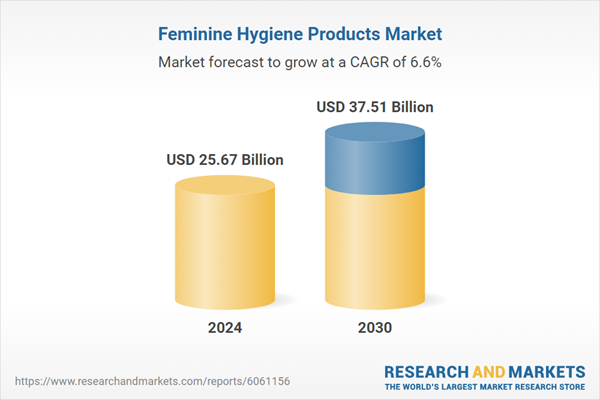Free Webex Call
The Feminine Hygiene Products Market was valued at USD 25.67 Billion in 2024, and is expected to reach USD 37.51 Billion by 2030, rising at a CAGR of 6.59%. The global feminine hygiene products market is experiencing steady growth, driven by increasing awareness of menstrual health, rising disposable incomes, and advancements in product innovation. Consumers are shifting towards organic, biodegradable, and reusable products due to growing environmental concerns. Speak directly to the analyst to clarify any post sales queries you may have.
10% Free customizationThis report comes with 10% free customization, enabling you to add data that meets your specific business needs.
The expansion of e-commerce platforms has enhanced accessibility, particularly in emerging markets. Leading brands focus on sustainability, comfort, and affordability, with innovations such as period panties and menstrual cups gaining popularity. Recent data indicates that individuals spend approximately USD 120 to USD 180 annually on menstrual products. Over a lifetime, depending on cycle length, total spending can exceed USD 5,000. These factors further drive the market demand over the forecast period.
Key Market Drivers
Rising Awareness and Education on Menstrual Hygiene
One of the primary drivers of the global feminine hygiene products market is the increasing awareness and education surrounding menstrual health. Governments, NGOs, and private organizations are actively working to break taboos and promote menstrual hygiene education, particularly in developing countries where access to products remains limited. Campaigns and initiatives, such as the United Nations’ Menstrual Hygiene Day and local government programs, are encouraging open discussions and improving accessibility to sanitary products. Additionally, schools and healthcare providers are integrating menstrual hygiene education into curriculums, further empowering women and young girls with knowledge about proper hygiene practices. This growing awareness is fostering higher adoption rates of feminine hygiene products worldwide.Key Market Challenges
Affordability and Accessibility in Low-Income Regions
One of the most significant challenges in the global feminine hygiene products market is the lack of affordability and accessibility, particularly in low-income and rural regions. Many women and girls in developing countries struggle to access sanitary products due to financial constraints, leading to the use of unhygienic alternatives such as cloth, leaves, or newspaper. High product costs, combined with limited distribution channels, make it difficult for underprivileged communities to obtain essential menstrual care products.Additionally, heavy import duties and taxes on feminine hygiene products in some countries further inflate prices, making them unaffordable for a large segment of the population. Efforts to remove or reduce the "tampon tax" in various nations have gained traction, but many regions still impose high taxes on these essential items. Governments and non-governmental organizations (NGOs) are working to bridge this gap by distributing free or subsidized sanitary products, but large-scale affordability remains a pressing concern. Expanding low-cost, locally produced alternatives and improving distribution networks are crucial steps toward overcoming this challenge.
Key Market Trends
Rising Demand for Sustainable and Eco-Friendly Products
Sustainability has become a major focus in the feminine hygiene market as consumers become more conscious of the environmental impact of disposable menstrual products. Traditional sanitary pads and tampons contribute significantly to plastic waste, with billions of products ending up in landfills each year. As a result, there is growing demand for biodegradable and reusable alternatives, such as organic cotton tampons, biodegradable pads, menstrual cups, and period underwear.Companies are responding by investing in sustainable materials, such as bamboo fiber, plant-based polymers, and compostable packaging. Leading brands and startups alike are launching eco-friendly product lines to cater to environmentally conscious consumers. Governments and regulatory bodies are also pushing for sustainable alternatives by encouraging bans on plastic-based hygiene products and promoting policies that support greener solutions. This shift towards sustainability is expected to continue shaping the market, driving innovation and influencing consumer choices.
Key Market Players
- The Procter & Gamble Company
- Glenmark Pharmaceuticals Limited
- Unilever PLC
- Unicharm Corporation
- Edgewell Personal Care Brands, LLC
- Premier FMCG (Pty) Limited
- Essity AB
- Ontex BV
- Kao Corporation
- Prestige Consumer Healthcare Inc.
Report Scope:
In this report, the Global Feminine Hygiene Products Market has been segmented into the following categories, in addition to the industry trends which have also been detailed below:Feminine Hygiene Products Market, By Product Type:
- Sanitary Pads
- Intimate Cleaners & Sprays
- Intimate Hair Remover
Feminine Hygiene Products Market, By Sales Channel:
- Supermarket/Hypermarket
- Online
- Pharmacies/Drugs Stores
- Online
- Others
Feminine Hygiene Products Market, By Region:
- North America
- United States
- Canada
- Mexico
- Asia-Pacific
- China
- Japan
- India
- Australia
- South Korea
- Indonesia
- Europe
- France
- United Kingdom
- Italy
- Germany
- Spain
- South America
- Argentina
- Colombia
- Brazil
- Middle East & Africa
- South Africa
- Saudi Arabia
- UAE
- Turkey
Competitive Landscape
Company Profiles: Detailed analysis of the major companies present in the Global Feminine Hygiene Products Market.Available Customizations:
With the given market data, the publisher offers customizations according to a company's specific needs. The following customization options are available for the report.Company Information
- Detailed analysis and profiling of additional market players (up to five).
This product will be delivered within 1-3 business days.
Table of Contents
1. Introduction
2. Research Methodology
3. Executive Summary
4. Voice of Customers
5. Global Feminine Hygiene Products Market Outlook
6. North America Feminine Hygiene Products Market Outlook
7. Asia Pacific Feminine Hygiene Products Market Outlook
8. Europe Feminine Hygiene Products Market Outlook
9. South America Feminine Hygiene Products Market Outlook
10. Middle East & Africa Feminine Hygiene Products Market Outlook
11. Market Dynamics
12. Impact of COVID-19 on Global Feminine Hygiene Products Market
14. Competitive Landscape
15. Strategic Recommendations/Action Plan
Table Information
| Report Attribute | Details |
|---|---|
| No. of Pages | 181 |
| Published | March 2025 |
| Forecast Period | 2024 - 2030 |
| Estimated Market Value ( USD | $ 25.67 Billion |
| Forecasted Market Value ( USD | $ 37.51 Billion |
| Compound Annual Growth Rate | 6.5% |
| Regions Covered | Global |
| No. of Companies Mentioned | 10 |









